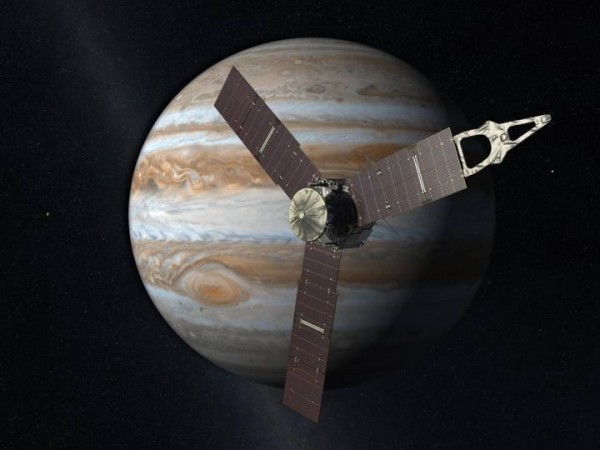By Ana Verayo, | January 17, 2016

The Juno spacecraft will arrive at Jupiter in 2016 to study the giant planet from an elliptical, polar orbit.
A tiny, solar-powered spacecraft known as NASA's Juno is now breaking records as it is now the farthest travelling solar-powered probe, at 493 million miles on Wednesday as it is now en route to Jupiter. The last record was broken by European Space Agency's comet chasing Rosetta spacecraft.
Like Us on Facebook
The spacecraft possesses a 30 feet long array of solar panels, consisting of 18,000 solar cells, is now five times farther away from the distance of the sun to the Earth. Rosetta made history by travelling 492 million miles to orbit around a comet however, Juno will be travelling 20 million miles more in order to reach Jupiter.
According to principal investigator Scott Bolton of the Southwest Research Institute in San Antonio, Juno will be able to provide crucial insight about the solar system and life's origins with breakthrough technology. Technology today provided numerous techniques to peek through the clouds of Jupiter and reveal the gas giant's secrets, including the solar system's evolution. He adds that this is another first in space exploration, as the team of scientists and engineers are working hard to achieve this where the best is yet to come.
Apart from breaking records, the goal of this mission is to better understand the biggest planet in the solar system in order to understand where we come from. Scientists believe that the spacecraft can transcend the 500 million mile mark since there are only eight spacecrafts that exceeded 500 miles, however, all are nuclear powered.
Apart from this, Juno will also become the second solar powered space vehicle to travel past the major asteroid belt between Mars and Jupiter, where the probe will conduct its rendezvous on July 4, with only 1/25th power from the sun from the beginning of its journey.
Back in 2011, the solar power arrays of Juno were too massive to launch into space however, after streamlining the design, the arrays became crucial for converting sunlight to energy in the most efficient way possible. To date, the probe can perform a 28 percent conversion rate that is enough to generate 500 watts of power when it reaches Jupiter. This is not a lot of power however, this is enough to keep Juno fully operational.
When the probe reaches Jupiter, it will spend the following year orbiting the massive world 33 times over. Every two weeks, Juno will reach 3,100 kilometers above Jupiter's thick cloudy atmosphere where the probe will study the planet's auroras, atmosphere, magnetosphere and structure. Juno's journey will then complete a total of 517 million miles from the sun.
-
Use of Coronavirus Pandemic Drones Raises Privacy Concerns: Drones Spread Fear, Local Officials Say

-
Coronavirus Hampers The Delivery Of Lockheed Martin F-35 Stealth Fighters For 2020

-
Instagram Speeds Up Plans to Add Account Memorialization Feature Due to COVID-19 Deaths

-
NASA: Perseverance Plans to Bring 'Mars Rock' to Earth in 2031

-
600 Dead And 3,000 In The Hospital as Iranians Believed Drinking High-Concentrations of Alcohol Can Cure The Coronavirus

-
600 Dead And 3,000 In The Hospital as Iranians Believed Drinking High-Concentrations of Alcohol Can Cure The Coronavirus

-
COVID-19: Doctors, Nurses Use Virtual Reality to Learn New Skills in Treating Coronavirus Patients







